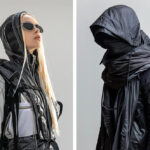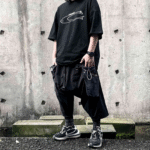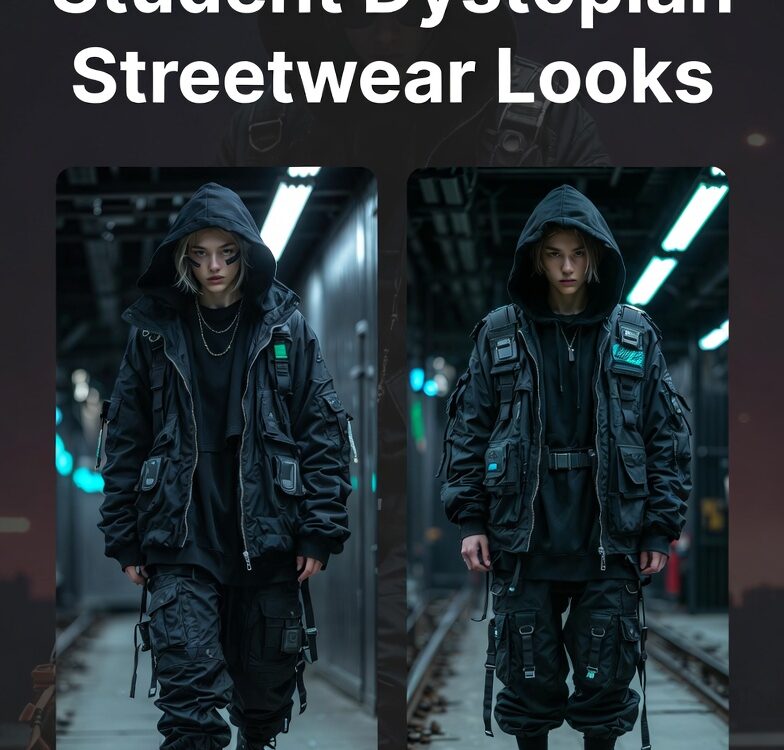
How to Style Dystopian Streetwear: Grunge Layers, Utility Gear, and Attitude
April 30, 2025
Top 10 Dystopian Streetwear Pieces You Need in Your Wardrobe
April 30, 2025Introduction: A Brave New Style
In a world dominated by uncertainty, chaos, and change, fashion has always served as a mirror to society. One of the most captivating shifts in recent years is the emergence of dystopian fashion—a raw, utilitarian, and futuristic style—seeping into the veins of high-end streetwear. Once confined to sci-fi movies or avant-garde runways, this aesthetic now defines some of the most influential luxury urban brands.
With climate crises, political instability, and digital transformation shaping our reality, designers are interpreting these anxieties into wearable art. This article explores how dystopian themes have transitioned from runway spectacles to the mainstream streets, creating a bold, survivalist fashion culture.
What is Dystopian Fashion?
Dystopian fashion draws inspiration from imagined future worlds where society has collapsed or radically transformed. It often features:
-
Muted, earth-toned palettes
-
Deconstructed or layered garments
-
Utility-inspired elements like cargo pockets, buckles, and tactical gear
-
Techwear aesthetics and post-apocalyptic silhouettes
-
Futuristic, unisex designs
This style isn’t just about appearance—it’s a philosophy. It reflects resilience, anti-establishment narratives, and a need to adapt to hostile environments.
The Origins: From Sci-Fi to Style Icons
Dystopian fashion isn’t new. It has deep roots in:
-
Movies and literature such as Blade Runner, Mad Max, and The Hunger Games
-
Cyberpunk subcultures that combine digital decay with rebellion
-
Japanese streetwear pioneers like Yohji Yamamoto and Rei Kawakubo who embraced asymmetry and bleak elegance
Designers turned to dystopia as a form of storytelling. As a result, the fashion industry began blurring the lines between costume, concept, and reality.
The Rise of Dystopian Influences in High-End Streetwear
1. Techwear and Tactical Aesthetics
High-end streetwear has increasingly embraced techwear—a style that focuses on functionality and futuristic aesthetics. Brands like Acronym, A-COLD-WALL, and Guerilla-Group* specialize in garments that fuse performance with cyberpunk edge.
Elements such as:
-
Waterproof zippers
-
Modular attachments
-
Hidden compartments
-
Layered constructions
Transform everyday outfits into survival gear fit for a digital wasteland.
2. Deconstruction and Oversized Silhouettes
Luxury streetwear houses like Balenciaga, Rick Owens, and Y/Project push the boundaries of proportion and symmetry. Oversized hoodies, elongated sleeves, and intentionally “unfinished” edges echo a world in disarray.
These styles don’t just look edgy—they symbolize the breakdown of traditional fashion norms and a move toward anti-fashion aesthetics.
3. Gender-Neutral and Fluid Design
In dystopian universes, identity is often stripped or blurred. This manifests in fashion as a move toward genderless silhouettes, a hallmark of many high-end streetwear collections.
Brands like 1017 ALYX 9SM and Maison Margiela experiment with form and fluidity, promoting androgyny as a response to rigid gender roles and societal collapse.
Key Designers and Brands Fueling the Dystopian Wave
Rick Owens
Often dubbed the “Lord of Darkness” in fashion, Rick Owens is synonymous with dystopian glam. His collections blend grunge, gothic, and futuristic elements, creating an apocalyptic aesthetic that still feels luxurious.
Demna (Balenciaga)
Balenciaga’s creative director Demna has redefined streetwear with bleak runway shows and oversized, armor-like designs. His vision echoes a world on edge—one filled with refugee-like models and war-torn landscapes.
Errolson Hugh (Acronym)
As a leader in techwear, Acronym founder Errolson Hugh mixes street culture with cutting-edge fabric technology. His garments are both conceptual and practical, turning wearers into modern nomads.
Samuel Ross (A-COLD-WALL*)
Ross bridges architectural minimalism with working-class British aesthetics, reflecting a dystopia grounded in class divides and industrial landscapes.
Cultural and Social Drivers of the Trend
Global Anxiety and Climate Crisis
The global atmosphere is tense—pandemics, climate disasters, AI threats, and war dominate headlines. Fashion, inherently reactive, transforms these fears into a dystopian style language.
Outfits that look like body armor or tactical suits express a collective desire for protection and preparedness in uncertain times.
Digital Alienation and Metaverse Influence
As we migrate into virtual spaces, fashion adapts. Dystopian fashion in streetwear mimics this tech immersion:
-
Augmented reality integration
-
LED and light-reactive materials
-
NFT-based digital fashion drops
Designers are blending the real with the surreal, pushing the boundaries of what clothing can mean.
Rebellion Against Fast Fashion and Waste
Dystopian fashion often incorporates upcycling, deconstruction, and reused materials—symbolizing resistance against mass production. Brands use these tactics not only as aesthetic choices but as statements of sustainability and activism.
Streetwear Consumers: Why Dystopia Appeals
Identity and Individualism
In a homogenized world, dystopian streetwear helps individuals stand out. The unique combinations of layers, textures, and accessories allow wearers to curate personal armor that reflects inner strength or resistance.
Symbol of Social Awareness
Wearing dystopian-inspired fashion signals an awareness of societal issues. It’s a style choice—and a political stance.
Tech-Savvy, Future-Focused Audience
Young streetwear enthusiasts are often early adopters of technology. Dystopian fashion, with its techwear roots, appeals to a demographic that lives online and embraces both style and utility.
Streetwear Collaborations and Limited Drops
Luxury streetwear thrives on collaborations, and dystopian aesthetics are often central themes. Some notable examples:
-
Nike x ACRONYM – Blending performance wear with survivalist looks
-
Adidas x Craig Green – Sculptural, futuristic sneakers
-
Balenciaga x Fortnite – A digital-physical fusion grounded in cyber-dystopia
These drops are often limited, increasing demand and positioning dystopian fashion as exclusive and elite.
The Future of Dystopian Fashion in Streetwear
As the world becomes more digitized and decentralized, dystopian fashion will likely evolve:
-
AI-designed clothing may dominate streetwear collections
-
Wearable tech and AR garments could offer real-time functionality
-
Hyper-personalized fashion through 3D scanning and custom fits may become the norm
Expect more boundary-pushing designs where form meets fear, and utility meets art.
FAQs About Dystopian Fashion in Streetwear
Q1. What defines dystopian fashion?
Dystopian fashion is characterized by rugged textures, utility-based design, asymmetry, techwear influences, and often a post-apocalyptic or futuristic feel.
Q2. Which streetwear brands are most influenced by dystopia?
Key brands include Rick Owens, ACRONYM, Balenciaga, A-COLD-WALL*, and Guerilla-Group.
Q3. Is dystopian fashion wearable every day?
Absolutely. While runway looks are often exaggerated, many pieces—like cargo joggers, tech jackets, or tactical vests—are highly wearable and functional for daily use.
Q4. How does dystopian fashion differ from grunge or punk?
While grunge and punk are rebellion-focused, dystopian fashion is future-oriented, often with tech and survivalist elements. It reflects societal anxiety through a sci-fi lens.
Conclusion: Embracing the Ruins with Style
From ruined cities to concrete runways, dystopian fashion has redefined high-end streetwear. It’s more than a trend—it’s a reflection of our collective psyche, our fears, and our fight to remain stylish in a world that’s constantly changing.
As fashion continues to evolve, the dystopian aesthetic will serve as a canvas for storytelling, innovation, and rebellion. In a reality teetering on the edge of science fiction, we might as well dress the part.



